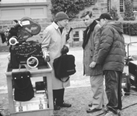A Beautiful Mind---The Movie
March 3, 2002

On location: John Nash with Russell Crowe, the actor who portrays him in A Beautiful Mind, and Ron Howard, the film's director. Photographs from The Essential John Nash.
James Case
So determined were screenwriter Akiva Goldsman and director Ron Howard to exhibit their disdain for the mere facts of John Nash's remarkable life that they forced him into graduate school a year ahead of schedule, in 1947 instead of 1948. Then, to strengthen the love story aspect of their tale, they wrote Nash's firstborn son---the mother of whom Nash refused to marry---entirely out of the script, along with his divorce, recent remarriage (to his original wife, Alicia), and homosexual activities. Next, they portrayed Nash as a gifted breaker of Russian codes, thereby enabling themselves to incorporate a car chase. There is of course no record that his summertime duties at the RAND Corporation---his closest brush with the military/industrial complex---ever included active participation in the Cold War.
In perhaps the cruelest misrepresentation of all, they foster the impression that Nash worked alone. In reality, of course, he was among the most interactive of mathematicians, endlessly discussing problems with colleagues and soliciting their assistance. The departments in which he worked after completing his thesis on game theory encouraged him to attack hard problems by furnishing able mentors---including D.C. Spencer at Princeton, Norman Levinson at MIT, and Lars H�rmander at Courant---to serve as sounding boards for his many ideas.
Perhaps the movie makers altered his story for the same reasons that Pulitzer Prize-winning biographer Edmund Morris chose to write Dutch, his authorized biography of Ronald Reagan, in the form of a historical novel. Or perhaps they felt that they had to embellish the facts in order to succeed at the box office. Exciting as Nash's career has been to his colleagues, it would be difficult to convey on the silver screen the impact of his work on real algebraic manifolds, his imbedding theorem, or the Nash-de Giorgi estimates.
The actors in the film obviously sensed a challenge, and strove to meet it. Russell Crowe mastered the awkward posture evident in pictures of Nash as a young man, and incorporated it into a shuffling walk that Nash's contemporaries would probably recognize. Some of the other mannerisms and inflections of speech seem equally authentic. It is unfortunate that Crowe no longer has the "body of a Greek God"---which at least one male contemporary attributes to Nash---nor the "cute legs" female acquaintances recall, and never displays the wit and fledgling social graces some say Nash began to develop after leaving grad school. The fair Jennifer Connelly performs credibly as the long-suffering Alicia.
The few scenes in the movie that correspond to actual events are played for dramatic effect, rather than historical accuracy. The content of Solomon Lef-schetz's welcoming address to Princeton's incoming class of math graduate students, the dialogue attributed to Alicia Larde (who eventually became Nash's wife) on the occasion of their first meeting, and the circumstances of his original commitment to the McLean Psychiatric Hospital outside Boston could have been lifted from any of a thousand B-movie scripts. In short, there is a lot to dislike about the movie under review, and this reviewer came close to walking out in disgust after the first thirty minutes. Yet there came a time---almost a moment of revelation---when it became clear what the movie makers were up to.
Instead of trying to explain what was remarkable about Nash and his mathematics, they have concocted a sequence of three fictitious scenes depicting his meteoric rise to professional prominence. In the first, Lefschetz points out to him that he has yet to accomplish anything of consequence as a graduate student, and that the department may be unable to find him a job after graduation. In the second, Nash is struck---in a bar where he and some fellow grad students are attempting to pick up girls---by a flash of inspiration to the effect that Adam Smith had it all wrong, and that a theorem asserting the existence of what are now called "Nash equilibrium points" would revolutionize economic science. In the third, Lefschetz is shown leafing through Nash's thesis and explaining that, after a "breakthrough of this magnitude," his job-hunting worries are over. Subsequently, Nash is treated with obvious deference wherever he goes.
The only thing the film really tries to get right---and probably does---is the nature of Nash's illness and recovery. For the better part of thirty years, he was plagued by delusions, which by his own account "came to him in the same way as his mathematical ideas." In the movie, these delusions assume human form and, at least during the early stages of his illness, seem as real and tangible as anyone else. Later on, he learns to distinguish the real people from the imaginary ones, and to ignore the latter. Though his delusions have never completely left him, and probably never will, he has learned to recognize and deal with them. To his biographer Sylvia Nasar, he has likened his "cure" to being on a diet that never ends: There are certain tempting thoughts from which he can never completely escape, and to which he knows he must never again yield. He is engaged in a never ending---and occasionally unsuccessful---fight to banish them from his consciousness.
The final scenes in this fascinatingly flawed film provide Hollywood's obligatory happy ending. They show Nash accepting the Nobel Prize in economics, sharing credit for his achievements and recovery with his wife, interacting constructively with Princeton students, and accepting the homage of his Princeton colleagues in a ridiculously contrived ritual involving pens.
James Case writes from Baltimore, Maryland.

